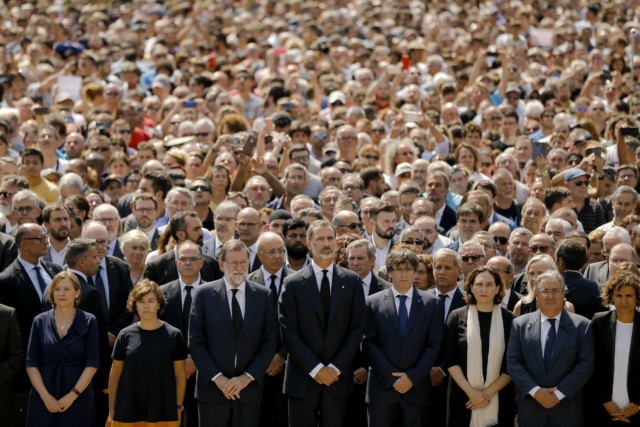Spanish police intensified a manhunt Friday for suspects behind two deadly vehicle attacks on civilians, shooting and killing five people wearing fake bomb belts who attacked a seaside resort and arresting four others believed linked to the carnage wrought on a Barcelona promenade.
Spanish authorities said the back-to-back vehicle attacks Thursday afternoon and early Friday morning — as well as a deadly explosion earlier this week in a house elsewhere in Catalonia — were related and the work of a large terrorist group.
The Islamic State group quickly claimed responsibility for Europe’s latest bout of extremist violence, which left 13 dead and 100 wounded after a van roared down Barcelona’s historic Las Ramblas promenade on Thursday. Hours later, a blue Audi plowed into people in the popular seaside town of Cambrils, killing one person and injuring five others.
Spanish Prime Minister Mariano Rajoy declared Friday that the fight against terrorism was a global battle and Europe’s main problem.
Police said they arrested two more people Friday, after an initial two were arrested Thursday — three Moroccans and one Spaniard, none with terror records. At least three of them were nabbed in the northern town of Ripoll. Another arrest was made in Alcanar, south of Barcelona, where a gas explosion in a house Wednesday that killed one person was also being investigated as a focus of the probe.
“There could be more people in Ripoll connected to the group,” regional Interior Ministry chief Joaquim Forn told TV3 television, adding that police were centering the investigation on identifying the five dead attackers in Cambrils as well as the driver of the Barcelona van.
Forn told local radio RAC1 that the Cambrils and Barcelona attack “follows the same trail. There is a connection.”
“We are not talking about a group of one or two people, but rather a numerous group,” he told Onda Cero radio.
Amid heavy security, Barcelona tried to move forward Friday, with its iconic Las Ramblas promenade quietly reopening to the public and King Felipe VI and Rajoy joining thousands of residents and visitors in observing a minute of silence in the city’s main square.
“I am not afraid! I am not afraid!” the crowd chanted in Catalan.
But the dual attacks unnerved a country that hasn’t seen an Islamic extremist attack since 2004, when al-Qaida-inspired bombers killed 192 people in coordinated assaults on Madrid’s commuter trains. Unlike France, Britain, Sweden and Germany, Spain has largely been spared, thanks in part to a crackdown that has netted some 200 suspected jihadis in recent years.
Authorities were still reeling from the Barcelona van attack when police in the popular seaside town of Cambrils, 130 kilometers (80 miles) to the south, fatally shot five people near the town’s boardwalk who had plowed into tourists and locals with their car. Forn said the five were wearing fake bomb belts.
One woman died Friday from her injuries, Catalan police said. Five others were injured.
Cambrils Mayor Cami Mendoza said the town had taken precautions after the Barcelona attack, but that the suspects had focused their attack on the narrow path to the boardwalk, which is usually packed late into the evening.
“We were on a terrace, like many others,” said bystander Jose Antonio Saez. “We heard the crash and intense gun shots, then the dead bodies on the floor, shot by the police. They had what looked like explosive belts on.”
Others described scenes of panic, and found safety inside bars and restaurants until police had secured the area. Resident Markel Artabe was heading out to get an ice cream when he heard the shots.
“We began to run. We saw one person lying on the pavement with a shot in his head, then 20 to 30 meters farther on we saw two more people, who must have been terrorists as they had explosive belts around them. We were worried so we hid,” he said.
The Cambrils attack came hours after a white van veered onto Barcelona’s picturesque Las Ramblas promenade and mowed down pedestrians. That attack at the peak of Spain’s tourist season left victims sprawled across the street, spattered with blood and writhing in pain from broken limbs. Others were ushered inside shops by officers with their guns drawn or fled in panic, screaming and carrying young children in their arms.
“It was clearly a terror attack, intended to kill as many people as possible,” said Josep Lluis Trapero, a senior police official for Spain’s Catalonia region.
Forn also suggested a possible connection to an incident Thursday in which the driver of a Ford Focus plowed through a police checkpoint leaving Barcelona after the Las Ramblas attack, injuring two police officers. The driver was killed.
The Islamic State group said on its Aamaq news agency that the Barcelona attack was carried out by “soldiers of the Islamic State” in response to the extremist group’s calls for followers to target countries participating in the coalition trying to drive it from Syria and Iraq.
Islamic extremists have nearly systematically targeted Europe’s major tourist attractions in recent years. Rented or hijacked vehicles have formed the backbone of a strategy to target the West and most notably its cultural symbols. Barcelona’s Las Ramblas is one of the most popular attractions in a city that swarms with foreign tourists in August.
The dead and wounded hailed from 34 countries, and previous attacks — in Nice, Paris, Berlin and London — have had similarly international victims.
Spanish public broadcaster RTVE and other news outlets named one of the detained in the Barcelona attack as Driss Oukabir, a French citizen of Moroccan origin. RTVE reported that Oukabir went to police in Ripoll to report that his identity documents had been stolen. Spanish media said documents with his name were found in the attack van and that he claimed his brother might have stolen them.
Citing police sources, Spain’s RTVE as well as El Pais and TV3 identified the brother, Moussa Oukabir, as the suspected driver of the van. Forn declined to respond to questions about him Friday.
“We don’t know if the driver is still in Barcelona or not, or what direction he fled in,” Forn told SER Radio.
Rajoy called the killings a “savage terrorist attack” and said Spaniards “are not just united in mourning, but especially in the firm determination to beat those who want to rob us of our values and our way of life.”
By Friday morning, Las Ramblas promenade had reopened to the public, albeit under heavy surveillance and an unusual quiet.
“It’s sad,” New York tourist John Lanza said, as the family stood outside the gated La Boqueria market. “You can tell it’s obviously quieter than it usually is, but I think people are trying to get on with their lives.”
At noon Friday, a minute of silence honoring the victims was observed at the Placa Catalunya, near the top of the Las Ramblas where the van attack started. The presence of Spain’s king and prime minister alongside Catalonia’s regional authorities marked a rare moment when the question of Catalonian independence — the subject of a proposed Oct. 1 referendum — didn’t divide its people.
Rajoy declared three days of national mourning.
Since the Madrid train bombings, the only deadly attacks in Spain had been bombings claimed by the Basque separatist group ETA that killed five people over the past decade. It declared a cease-fire in 2011.
“Unfortunately, Spaniards know the absurd and irrational pain that terrorism causes. We have received blows like this in recent years, but we also that terrorists can be beaten,” Rajoy said.
 CGTN America
CGTN America
 King Felipe of Spain, center, Prime Minister Mariano Rajoy, center left, and and Catalonia regional President Carles Puigdemont, center right, join people observing a minute of silence in memory of the terrorist attacks victims in Las Ramblas, Barcelona, Spain, Friday, Aug. 18, 2017. (AP Photo: Francisco Seco)
King Felipe of Spain, center, Prime Minister Mariano Rajoy, center left, and and Catalonia regional President Carles Puigdemont, center right, join people observing a minute of silence in memory of the terrorist attacks victims in Las Ramblas, Barcelona, Spain, Friday, Aug. 18, 2017. (AP Photo: Francisco Seco)
